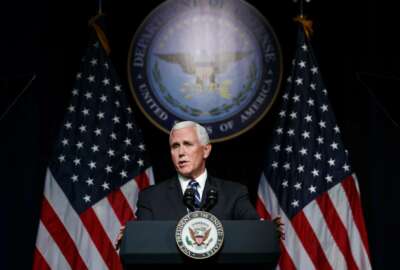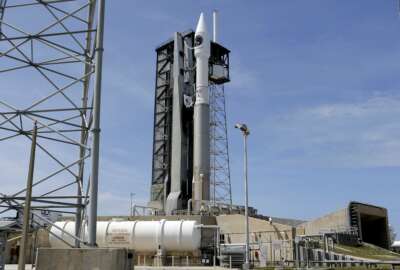
Fights, budgeting and planning are all ahead if DoD wants to set up a space force by 2020
President Donald Trump has called for the creation of a space force as a separate military service, but there hasn't been a new military service since 1947.
Best listening experience is on Chrome, Firefox or Safari. Subscribe to Federal Drive’s daily audio interviews on Apple Podcasts or PodcastOne.
The White House’s plan for a space force is officially out in the open, but now comes the hard part.
In the next 18 months to two years, Congress and the administration will have to figure out everything from office space to budgetary resources if they want the space force to become a reality.
On top of that, lawmakers and budget experts say the defense budget is unlikely to rise any more in the coming years, setting up a battle between the current military services and the space force for funds.
“Creating a new service is about as complicated as it gets,” said Eric Fanning, former Army secretary and currently the president and CEO of the Aerospace Industries Association. “There are an enormous amount of issues, small to large, that are going to have to be worked through.”
The U.S. hasn’t formed a new armed service since 1947 when the War Department was converted into the Defense Department and the Air Force was added as a separate service from the Army.
As the military accepts that space is becoming a more important domain, the way it handles space will need to change.
“The administration has succeeded in focusing attention on a very important issue. More attention than it’s ever received and they should get credit for that because the threats in space are severe and they are increasing,” Fanning said.
Now, more than 70 years later, Fanning says DoD and Congress are going to be flying mostly blind in order to create the space force by 2020.
Budget Control Act limits DoD funding
Under the current budget deal, Congress can appropriate $617 billion to DoD (not counting overseas contingency spending) without triggering sequestration in 2019.
For 2020, Congress will need to deal with the return of the Budget Control Act, which limits DoD’s funding to $549 billion unless lawmakers come to another deal.
But even if lawmakers come to an agreement, there will be four military services fighting for their piece of the budget.
Adam Routh, a research associate at the Center for a New American Security, says adding a space force is like adding another lion to fight over the budget meat.
“We are taking money from the other services,” Routh said. “There would be some money that would come from what we already spend on space. What the Air Force gets, for example, or what the other branches are spending on space, but it wouldn’t be enough. It would need to come from other parts of the defense budget and it’s going to be substantial. You can’t set up a space force or any kind of force from the pennies left over from the programs we decide are unnecessary,” Routh said.
Latest Defense News
The military branches are already competitive about how they design their budgets and allocate resources, according to Routh.
He said a space force will create an additional stovepipe of bureaucracy that will advocate for funding in favor of their force.
Where DoD decides to cut for the space force could undermine some of the readiness work the military worked on the past few years, said Dan Grazier, a fellow at the Project on Government oversight.
“This is not going to be revenue neutral,” Grazier said. “As soon as you get a new branch of the military it’s going to have its own bases, they’re going to have their own uniforms, they will have their own internal bureaucracy. … It’s going to exacerbate [the readiness issue] to an incredible degree. Throughout the history of at least the last 70 years, the ground forces in particular seem to really get the short end of the stick as far as resources when [DoD] is constrained.”
Grazier said operations and maintenance tend to go by the wayside when DoD needs resources to fund a big project.
“When they have to make tradeoffs, they rob Peter to pay Paul as far as operations and maintenance for new acquisitions … any kind of new endeavor like this is going to steal funds and resources from ongoing operations and ongoing maintenance efforts,” he said.
Congressional role
The Pentagon is planning to set up a U.S. Space Command by the end of the year. The command will lead wartime operations in space and integrate space planning into military operations.
However, in order to create a whole new branch of the military like a space force, DoD will need congressional approval.
Deputy Defense Secretary Patrick Shanahan said during an Aug. 9 roundtable at the Pentagon that DoD is currently working on something to give Congress.
“The vision that the president has articulated is that we build a legislative proposal that would get at how you collect that community of interest, scaling the manpower and the talent so that we can accelerate our ability to deploy and employ capabilities in space,” Shanahan said. “It’s a two-step process. Getting the combatant command right so that we have the warfighter that’s going to do this work. That’s actually going to do command and control of forces and defense and deterrence in space is a critical step.”
The second step is creating the legislative proposal for what the space force as a service will look like.
Fanning said a lot of factors need to be taken into account.
“Where is the headquarters in the building? There are statutory limits on the number of senior officers in politically confirmed positions,” Fanning said. “How you are going to separate the budgets from the services as they exist now and the personnel? Who are you going to take? What are you going to take? What budget are you going to move in that creates this new force?” Fanning said.
Grazier said DoD will have to figure out the whole bureaucratic apparatus from personnel and manpower to acquisition.
That’s not to mention uniforms, ranks, training and everything in between. All of that needs to be codified in law.
The person who will be overseeing all this will be the deputy assistant secretary of defense for space policy.
The role is “supervisory, to hold someone accountable and see how things progress. It’s a civilian position to move the ball along or at least be accountable if it doesn’t,” Routh said.
Then there is the whole matter of congressional approval. When a similar idea for a “space corps” was first brought up by Reps. Mike Rogers (R-Ala.) and Jim Cooper (D-Tenn.), it took an excruciating amount of debate before it was added to the House version of the 2018 defense authorization bill.
That provision was later taken out in conference. A mandate for the space force didn’t make it into the 2019 version of the law either.
Grazier and Routh say convincing lawmakers to actually vote for a space force may be tricky.
Organizational and personnel issues
On top of all of this, the military still needs to operate in the space domain the way it has been in previous years.
Doing that while also planning one of the biggest changes to DoD in 70 years isn’t going to be a cakewalk, Fanning said. The whole point is to organize the space force to get the military into space faster.
“You don’t want the process itself to slow you down and you don’t want the end product to be something that slows you down,” Fanning said. “The concern is how do we go about protecting this resource, adding to the speed in which we can get capability launch without the process actually slowing us down. There is a great deal of resource in DoD now, especially in the Air Force. I suspect that will be used for a space force, but the issue isn’t just the resource that you get out, it’s making sure it goes to capability instead of to bureaucracy.”
Fanning added that DoD needs to make sure it doesn’t create a space brain drain in the other services.
“All the services are dependent on space for fighting and you don’t want to completely gut the expertise that they need as you’re standing up a space force,” Fanning said.
Then there are the personnel problems DoD needs to take into account. The Air Force is already going through this issue with its pilots.
That service currently has a shortage of about 2,000 people because of the high demand for pilots in private industry. In some cases, pilots will obtain their required flying hours and training while in the service and then move to a private airline where they can command a larger salary.
Fanning said a space force will likely deal with the same issues.
“If you do stand up a space force, you are going to have a lot of highly trained, skilled, technical positions and those are generally attractive positions to people when you are recruiting so then retention becomes the issue because you give them exquisite training, they work through their commitment to the military and then they become very attractive to industry and other places,” Fanning said.
Read more of the DoD Personnel Notebook
Copyright © 2025 Federal News Network. All rights reserved. This website is not intended for users located within the European Economic Area.
Scott Maucione is a defense reporter for Federal News Network and reports on human capital, workforce and the Defense Department at-large.
Follow @smaucioneWFED




